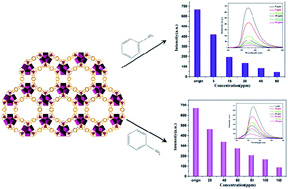A luminescent metal–organic framework for highly selective sensing of nitrobenzene and aniline†
Abstract
A stable nonanuclear rare earth carboxylate cluster based metal–organic framework, (DMA)2[Y9(μ3-OH)8(μ2-OH)3BTB6]n·(solv)x (gea-MOF-1) (DMA = dimethylamine cation and BTB = 1,3,5-benzene(tris)benzoate) can act as a fluorescent sensor for highly sensitive and selective detection of nitrobenzene and aniline through fluorescence quenching. More importantly, the detection limit of nitrobenzene is on the 5–60 ppm scale.


 Please wait while we load your content...
Please wait while we load your content...